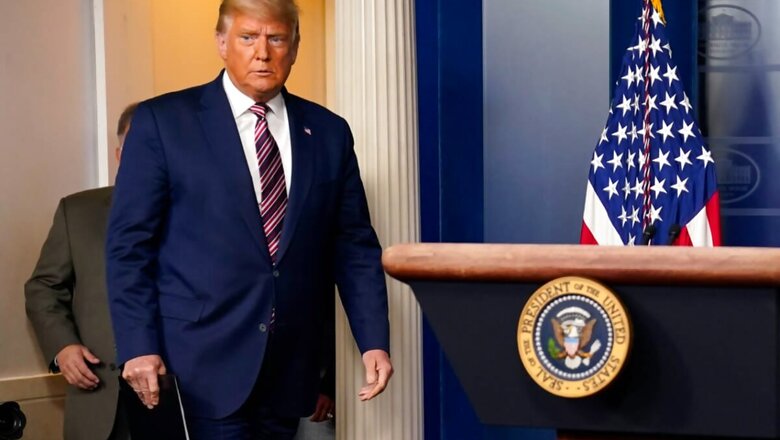
views
As he closed his campaign with a series of boisterous rallies, President Donald Trump told his cheering crowds they would prove all the experts wrong again – just as they had when he improbably won the US presidency in 2016.
“A great red wave is coming,” Trump said at an October 31 rally in Pennsylvania, predicting a surge of Republican support would carry him to re-election. “There’s not a thing they can do about it.”
Trump lost the White House, according to media outlets that called the tight race on Saturday morning for his Democratic opponent Joe Biden, the former vice president. And yet Trump clearly outperformed scores of polls that suggested he might lose in a landslide and proved his base of supporters was bigger and more loyal than many observers realised.
Democrats had hoped that voters would hand Trump a stark repudiation of his often chaotic first term and his divisive campaign. Instead, Trump has captured about 7.3 million more votes than he did in 2016, preliminary returns show. Many Republican lawmakers who faced election stuck by Trump through an impeachment last year and, this year, his widely maligned handling of the pandemic and the civil unrest over police killings of Black people. Some of those allies were rewarded with Senate victories that may allow the party to maintain a narrow majority.
Republicans also gained five seats in the US House of Representatives, which is controlled by Democrats. The Republican party’s strong showing, defying critics and pundits, came despite a massive fundraising advantage enjoyed by Democrats at the campaign’s end and, according to polls, a sharp turn of support toward Democrats in America’s suburbs.
The tight race came down to late-counted mail-in ballots in Georgia and Pennsylvania, which tipped the election to Biden. Trump, however, has not conceded. The incumbent, who received more votes than any Republican candidate in history, has sought to de-legitimise the outcome by claiming, without evidence, that he was cheated. There will likely be recounts in several states. And Trump continues to wage legal fights to nullify the results.
Still, Trump faces a formidable struggle to prevail in the Electoral College that decides U.S. elections. Each state is allotted electoral votes based on its population. In most states, the candidate that wins the popular vote takes all its electoral votes, no matter how close the margin of victory. In the popular vote nationally, Biden has so far racked up 4.1 million more votes than Trump.
The Trump campaign issued a statement Saturday morning saying the election was “far from over. Joe Biden has not been certified as the winner of any states, let alone any of the highly contested states.”
Trump tweeted: “I WON THIS ELECTION, BY A LOT!”
Even as states count the last ballots, the results have dashed Democrats’ hopes for the death of Trumpism. If Biden’s victory is certified and the Republicans retain the Senate, the new president may be handcuffed in his efforts to push legislation and win confirmations of judges and administration officials. Whatever the future for Trump himself, Democrats and Republicans alike said they will have to reckon with the continuing appeal of his brash brand of populist politics.
Joe Gruters, chairman of the Florida Republican Party, said that Trump’s message about economic liberty, even during the pandemic, won over many voters. “People voted for the president of the United States because of his positive messaging on the future and his going out of the way to put America first,” Gruters said.
“People don’t want taxes; they don’t want to be locked down. They want freedom and liberty. And they don’t want to see their communities burned to the ground,” he said, referring to incidents of looting and fire-setting during protests against killings by police this year.
Stu Rothenberg, a non-partisan political analyst, said the race underscored the resilience of Trump, who turned out legions of supporters from his base of white, often working-class voters and made inroads with Hispanic voters vital to the Democratic coalition.
The election was hardly the “smashing defeat” Democrats and anti-Trump Republicans wanted, Rothenberg said. “In some respects, the outcome wasn’t that different than four years ago, despite his failure to deal with the coronavirus and the economy,” Rothenberg said of Trump.
The tight election means Democrats will be asking themselves why “Trump is still with us,” said Karen Finney, a veteran Democratic strategist who was a spokesperson for Democrat Hillary Clinton’s 2016 presidential campaign. She said Trump continued to score successes with “dog whistle” politics – using veiled or coded rhetoric to inflame racial and cultural tensions. The close election, Finney said, proves “we are still a very, very divided country.”
The Trump campaign and the Republican National Committee did not respond to questions about Trump and the party’s performance in the election.
Defying The Experts
After four years of shunning experts on issues ranging from climate change to foreign policy to the coronavirus pandemic, Trump wasn’t about to listen to the pollsters, pundits and politicians who said he needed to steer his flagging campaign toward the moderate middle.
Instead, Trump went all-in on a divisive excite-the-base strategy – railing against liberal “anarchists,” his own administration’s public health experts and the legitimacy of the election itself. He finished the campaign with a string of rallies packed with mostly maskless supporters in a still-raging pandemic.
The preliminary election results underscored the depth of the nation’s partisan divide. After a year of the pandemic, an economic crash and widespread social unrest over police killings of black people, exit polls showed that few people crossed party lines.
Exit polls conducted by Edison Research showed that Trump retained the support of a solid majority of white voters, about 55%, a slight decline from his numbers in 2016. White non-college graduates who form the heart of Trump’s base still backed Trump over Biden by more than 20 points, but his margin in that group shrunk by about four points, according to the data.
Mike Madrid, a co-founder of the Lincoln Project – a group of former Republican political operatives who campaigned to defeat Trump and elect Biden – said he thinks Trumpism will remain the heart of the Republican Party.
“Trumpism, popular nationalism, white identity grievance politics will continue,” he said, noting the vast majority of elected Republicans had little appetite for anything different.
And yet Trump’s support rose by about four percentage points among African-Americans, Hispanics and Asian-Americans, compared with four years ago, the polling suggests. About 39% of older Hispanics cast ballots for Trump, up 14 points from 2016, while 19% of black voters between ages 30 and 44 backed the president, which is up 12 points from the last election. Meanwhile, Trump’s level of support slipped by about 2 points among older white voters.
In Florida, a 12-point surge towards Trump among Latino voters, compared with 2016, played an important role in handing him the big battleground state’s electoral votes.
Such gains flummoxed Trump’s opponents, who have long hammered the president for what they describe as his racist comments and harsh immigration policies. Notably, the president boosted his support in heavily Latino areas in Texas, overperforming Clinton’s totals by 11 to 27 points in counties along the state’s southern border with Mexico. In Hidalgo County, which is more than 90% Hispanic, Trump won 40,000 more votes than he did four years ago, increasing his vote share from 28% to 41%.
Biden’s low-profile campaign, which avoided the flesh-and-blood rallies that Trump thrived on, undoubtedly gave the president an upper hand with some Latino voters, one political scientist said. “The Rio Grande Valley, like other Latino-heavy places like Florida, is very much an old-school, grassroots place that needs a high-touch political approach,” said Victoria De Francesco Soto, assistant dean at the Lyndon B. Johnson School of Public Affairs at the University of Texas at Austin.
She said Trump helped himself with Latinos by not using what she called the racist rhetoric that he used in his campaign in 2016 when calling an immigration crackdown. She said it’s not surprising that voters shrugged off Trump’s stance on immigration because many Latinos who live near the border are fairly conservative on immigration issues.
Richard Cortez – a Democrat and the county judge, a top elected official, in Hidalgo County – said Trump’s big gains in the Rio Grande Valley came down to the economy and religion for more conservative Latinos.
The coronavirus pandemic has taken an intense toll on the region, where mobile morgues had to be brought in to handle a spike in deaths. Still, Cortez said, voters feared unemployment more than the virus, and embraced Trump’s call to open the U.S. economy, regardless of the pandemic.
The largely Catholic population in the Valley also welcomed Trump’s anti-abortion stance and his success in placing on the U.S. Supreme Court three conservative justices who voters hope may strike down Roe v. Wade.
Trump’s bravado, too, played well with Latinos, Cortez said.
“Hispanic voters often like a tough, John Wayne-type politician – somebody who will fiercely stand up for their ideals,” he said. “Some voters just felt that Trump was tougher.”
Rallies, Registration And Recruits
Polls all year showed that suburban women and older voters had shifted away from the president. But Trump never lost his appeal among the faithful – including evangelicals, pocketbook Republicans who liked his tax cuts and the mostly white, non-college-educated voters who once were a natural constituency for Democrats. They continued to trust Trump on the economy and reveled in his ridicule of Biden, who many consider a moderate, as a doddering tool of the radical left.
“Joe Biden – he’s not all there,” Trump told a crowd at a farm in Bucks County, Pennsylvania, on Oct. 31.
At a rally in Opa-locka, Florida, on Sunday – Trump’s fifth of the day, stretching past midnight – the president riled up fans with his dystopian vision of Biden’s America: closed factories, banned oil fracking, quadrupled taxes, defunded police departments, destroyed suburbs, gun confiscations, and anti-American indoctrination of school children. (Biden advocated none of these things.)
“Our opponents want to turn us into Communist Cuba or socialist Venezuela,” he said.
But the rally strategy went well beyond whipping up enthusiasm, campaign officials said. It included a much larger effort to recruit and register new members of the Trump tribe – often infrequent voters, who may not be Republicans.
To attend a Trump rally, an attendee had to sign up online or provide a cell phone number, used by the campaign to identify people who may not have voted in 2016, or ever. That meant every rally became what Trump campaign spokesman Tim Murtaugh called “an enormous data-gathering event” that pulled more people into the Trump camp. “It is not atypical for 30% of registrants for a rally to be non-Republican,” he said.
The combination of rallies and data-mining proved to be a potent campaign weapon – and created a database of supporters that Republicans can continue to build even after a Trump White House.
The campaign and the Republican Party invested heavily to grow the size of Trump’s base of support. Since the 2020 cycle began, the Republican Party has signed up 2.5 million volunteers who have performed 29.4 million door knocks and 128.9 million phone calls spread across battleground states, according to Rick Gorka, a Republican National Committee official involved in the effort. More than 2,000 paid staff have been spread across these states working for the president and the party, he said.
In states the campaign considered strategically important, it pinpointed clusters of Trump supporters or swing voters and targeted them for door-knocks and digital advertising.
“Those 2.5 million volunteers, that’s what they do,” Gorka said. “They would meet potential voters in their neighborhoods, churches, bars, coffee shops; it didn’t matter.” The rallies, Gorka said, brought in “a network of individuals that we would never be able to identify.”
Republicans quietly piled up strong margins in signing up new voters in swing states including North Carolina and Florida, helping to drive turnout even higher in some of the rural, mostly white and manufacturing-intensive counties where Trump enjoyed his deepest wells of support. But those numbers were offset by Democratic surges elsewhere.
These new Trump voters might explain why many pollsters notched embarrassing underestimates of the president’s support in some key swing states in 2020. Another possible reason: a hidden reserve of Trump voters who kept their preference quiet.
Ryan Landers, 46, waiting in line at the pre-election Trump rally in Pennsylvania’s Bucks County, said that some of his Trump-supporting friends got calls from pollsters and lied about their intention to vote for the president.
“Some people kept it to themselves because of the left,” added Bill Karcher, 48, a floor installer who said he voted for Obama and Hillary Clinton, but supported Trump this year. “You can’t have an opinion if you are for Trump. If you have a Trump sign, you’re going to catch shit for it.”
Trump’s rallies, however, brought out tens of thousands of loud-and-proud supporters. The gatherings had the feel of fan-filled music festivals, with a warmup playlist of baby boomer favorites and a video of the highlights of Trump’s first term. For the faithful, Trump represents something beyond a political figure.
“He is us, in the White House,” said Suzanne Landis, a hair stylist from Montgomery County, near Philadelphia. “He speaks for us.”
In closely fought Pinellas County, Florida, Tim Kennedy, 27, stood along a roadside last weekend waving flags for Trump – one of them showing an assault rifle with the words “Come and Take It.” Kennedy said the coronavirus crisis cost him his job as an engineering contractor for an arms manufacturer. But he doesn’t blame Trump.
“He’s not a saint, but he’s not a normal politician,” Kennedy said of Trump. “I think he genuinely cares about people.”
Read all the Latest News, Breaking News and Coronavirus News here




















Comments
0 comment